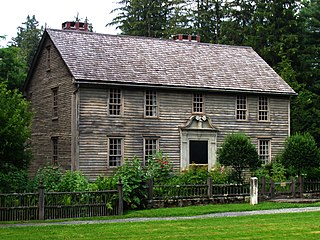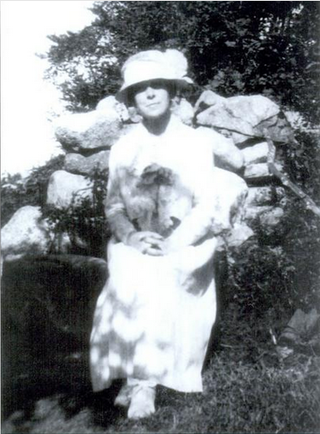
Essex is a coastal town in Essex County, Massachusetts, 26 miles (42 km) north of Boston and 13 miles (21 km) southeast of Newburyport. It is known for its former role as a center of shipbuilding. The population was 3,675 at the 2020 census.

Ipswich is a coastal town in Essex County, Massachusetts, United States. The population was 13,785 at the 2020 census. Home to Willowdale State Forest and Sandy Point State Reservation, Ipswich includes the southern part of Plum Island. A residential community with a vibrant tourism industry, the town is famous for its clams, celebrated annually at the Ipswich Chowderfest, and for Crane Beach, a barrier beach near the Crane estate. Ipswich was incorporated as a town in 1634.

Joseph Hodges Choate was an American lawyer and diplomat. Choate was associated with many of the most famous litigations in American legal history, including the Kansas prohibition cases, the Chinese exclusion cases, the Isaac H. Maynard election returns case, the Income Tax Suit, and the Samuel J. Tilden, Jane Stanford, and Alexander Turney Stewart will cases. In the public sphere, he was influential in the founding of the Metropolitan Museum of Art.

Rufus Choate was an American lawyer, orator, and Senator who represented Massachusetts as a member of the Whig Party. He is regarded as one of the greatest American lawyers of the 19th century, arguing over a thousand cases in a lifetime practice extending to virtually every branch of the law then recognized. Notably, he was one of the pioneers of the legal technique of arousing jury sympathy in tort cases. In one instance, he successfully won a record judgement of $22,500 for a badly injured widow, the most ever awarded to a plaintiff at the time. Along with his colleague and close associate Daniel Webster, he is also regarded as one of the greatest orators of his age. Among his most famous orations are his Address on TheColonial Age of New England delivered at the centennial celebration of the settlement of Ipswich, Massachusetts in 1831 and his Address on The Age of the Pilgrims as the Heroic Period of Our History before the New England Society of New York in 1843. Through these addresses, Choate became one of the most prominent advocates of promoting the Puritan settlers as the first founders of the American republic. A staunch nationalist and unionist, Choate was among several former Whigs to oppose the Republican Party over concerns that it was a "sectional party" whose platform threatened to separate the Union. In turn, he publicly voiced his support for Democratic candidate James Buchanan over Republican John C. Fremont in the 1856 Presidential election.

The National Portrait Gallery (NPG) is a historic art museum between 7th, 9th, F, and G Streets NW in Washington, D.C., in the United States. Founded in 1962 and opened to the public in 1968, it is part of the Smithsonian Institution. Its collections focus on images of famous Americans. Along with the Smithsonian American Art Museum, the museum is housed in the historic Old Patent Office Building.

The National Museum of American History: Kenneth E. Behring Center collects, preserves, and displays the heritage of the United States in the areas of social, political, cultural, scientific, and military history. Among the items on display is the original Star-Spangled Banner. The museum is part of the Smithsonian Institution and located on the National Mall at 14th Street and Constitution Avenue NW in Washington, D.C.

Naumkeag is the former country estate of noted New York City lawyer Joseph Hodges Choate and Caroline Dutcher Sterling Choate, located at 5 Prospect Hill Road, Stockbridge, Massachusetts. The estate's centerpiece is a 44-room, Shingle Style country house designed principally by Stanford White of McKim, Mead & White, and constructed in 1885 and 1886.

The National Museum of African American History and Culture (NMAAHC), colloquially known as the Blacksonian, is a Smithsonian Institution museum located on the National Mall in Washington, D.C., in the United States. It was established in 2003 and opened its permanent home in 2016 with a ceremony led by President Barack Obama.

The Green Room is one of three state parlors on the first floor of the White House, the home of the president of the United States. It is used for small receptions and teas. During a state dinner, guests are served cocktails in the three state parlors before the president, first lady, and a visiting head of state descend the Grand Staircase for dinner. The room is traditionally decorated in shades of green. The room is approximately 28 by 22.5 feet. It has six doors, which open into the Cross Hall, East Room, South Portico, and Blue Room.

The Mission House is an historic house located at 19 Main Street, Stockbridge, Massachusetts. It was built between 1741 and 1742 by a Christian missionary to the local Mahicans. It is a National Historic Landmark, designated in 1968 as a rare surviving example of a colonial mission house. It is now owned and operated as a nonprofit museum by the Trustees of Reservations.

Greenwood Farm is a historic property and nature reserve located in Ipswich, Massachusetts, and owned by The Trustees of Reservations. The farm is 216 acres of gardens, pastures, meadows, woodlands and salt marsh and it features the PaineHouse, a First Period farmhouse constructed in 1694.

The John Whipple House is a historic colonial house at 1 South Green in Ipswich, Massachusetts. Built in the seventeenth century, the house has been open to the public as a museum since 1899 and was the subject of some of the earliest attempts at the preservation of colonial houses. It was designated a National Historic Landmark in 1960, one of the earliest properties to receive that honor.

Choate Bridge (1764) is a historic stone arch bridge carrying Route 1A/Route 133 over the Ipswich River in Ipswich, Massachusetts. It is one of the oldest surviving bridges in North America, and is probably the oldest in Massachusetts. It was listed on the National Register of Historic Places in 1972 and also has been designated as a National Historic Civil Engineering Landmark.

The White–Ellery House is a historic house located at 247 Washington Street in Gloucester, Massachusetts. It is on the National Register of Historic Places. It is owned and operated by the Cape Ann Museum, whose headquarters is located at 27 Pleasant Street in Gloucester.

Rosemary Hall was an independent girls school at Ridgeway and Zaccheus Mead Lane in Greenwich, Connecticut. It was later merged into Choate Rosemary Hall and moved to the Choate boys' school campus in Wallingford, Connecticut.

Mary Brewster Hazelton was an American portrait painter. She attended the School of the Museum of Fine Arts, Boston, where she was later an instructor. Among her other achievements, Hazelton was the first woman to win an award open to both men and women in the United States when she won the Hallgarten Prize from the National Academy of Design in 1896. Her portrait paintings are in the collections of the Massachusetts State House, Harvard University, Peabody Essex Museum, and Wellesley Historical Society. The professional organizations that Hazelton was affiliated with included the Wellesley Society of Artists, of which she was a founding member, and The Guild of Boston Artists, of which she was a charter member. She lived her adult life with her sisters in the Hazelton family home in Wellesley, Massachusetts.

Among the Sierra Nevada, California is an 1868 oil-on-canvas painting by German-American artist Albert Bierstadt which depicts a landscape scene of the Sierra Nevada mountain range in California. Created at his studio in Rome, the painting was exhibited throughout Europe, creating interest in immigration to the United States. Measuring 72 by 120+1⁄8 inches, the painting is a centerpiece of the 19th-century landscape collection at the Smithsonian American Art Museum in Washington, D.C.

Ipswich lace is a historical fashion accessory, the only known American hand-made bobbin lace to be commercially produced. Centered in the coastal town of Ipswich, Massachusetts north of Boston, a community of lacemaking arose in the 18th century. Puritan settlers to the area likely made and wore lace as early as 1634, because Sumptuary laws from the early colonial records indicate this activity. Earliest known records of the commercial production indicate that lace produced by local women was used to barter for goods in the 1760s, as denoted by ledger account books belonging to local merchants. These laces were sold in the region from Boston to Maine.




















